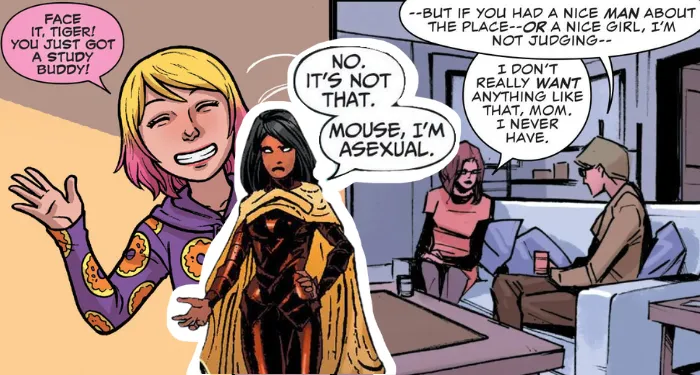
Ace of Capes: Asexual Superheroes, Villains, and More
As another Pride Month winds down, I’d like to take this opportunity to celebrate the asexual heroes, villains, and supporting characters who are on the ace spectrum. It’s a short list. But it’s growing!
First, though, just what is asexuality? Awareness has grown in recent years, but there’s still some confusion, so allow me to provide a quickie explanation. Asexuality refers to a broad spectrum of identities, all of which indicate a lack of sexual attraction to others. It is different from abstinence, which refers to lack of sexual activity regardless of orientation.
As I mentioned, asexuality is a spectrum. According to the split attraction model, a person’s romantic (hugging, kissing, holding hands) orientation does not necessarily have to align with their sexual (self-explanatory) orientation. For example, one can be a heteromantic asexual, meaning they are romantically attracted to people of a different gender and sexually attracted to no one. On the flip side, one could be an aromantic homosexual, meaning they are romantically attracted to no one and sexually attracted to people of the same gender. (All of these combinations qualify as queer, so no gatekeeping.)
Comics — including the characters mentioned here — tend to equate asexuality with aromanticism, which ignores the many aces who are in happy romantic relationships with people of all sexual orientations. So while I, an aro-ace reader, will never argue for less representation for myself, I would like to see comics acknowledge the wide variety of asexuality in the future.
Also, some of the characters listed here have yet to explicitly say they are asexual: they dance around it with statements about how they’re not interested in relationships. Sometimes the creators confirm they are asexual, but their statements have yet to be addressed in the comics. That, too, needs to change. Queer identities are now mainstream enough that we don’t need to sidestep or hide the issue as was done decades ago. Still, we should celebrate the progress ace characters have made, and that’s what I’m going to do right now.
Roshanna Chatterji
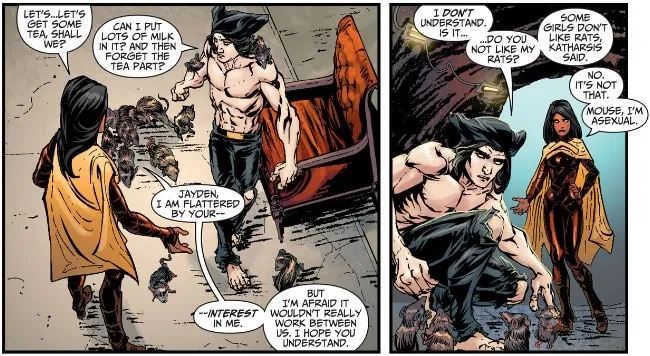
After a rebellious youth in both India and America, Roshanna was recruited by the U.S. government to spy on the Movement, a group of young people determined to protect their city from corrupt cops and politicians by any means necessary. As Tremor, Roshanna was uncomfortable with their more violent tactics, but she still regarded them as her friends and betrayed the government to protect them.
One member of the group, Mouse, developed a crush on Tremor, and she was forced to tell him that she is asexual in The Movement #10. There were no hard feelings between them, and Mouse soon turned his attentions to another woman, Margaret, who likes rats almost as much as he does.
Verity Willis
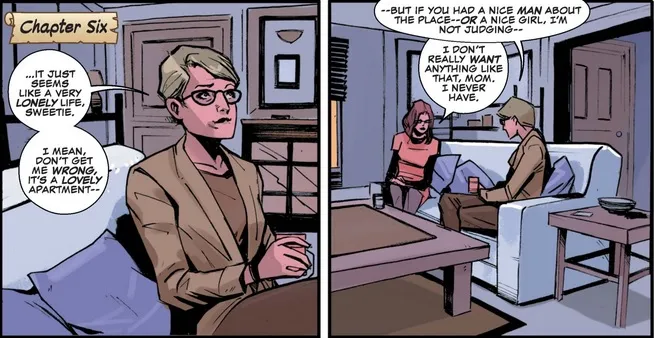
Verity Willis doesn’t like people in general, thanks to her superpower: she always knows when someone is lying. This overwhelming ability makes her a recluse until her mother pushes her into an evening of speed dating.
It is during this outing, depicted in Loki: Agent of Asgard #2, that we get the first hint that she might be asexual. Verity is clearly unimpressed by every single guy she talks to. This is also where she meets Loki, whose mortal disguise she sees through instantly. Her ability to detect lies — Loki’s stock in trade — makes the pair unusual yet compelling friends.
Still, her jadedness at the speed-dating event could easily be interpreted as disgust with the men’s lies, not with men or romance generally, until the third-to-last issue of AoA. Here, Verity told her mother she doesn’t “really want anything like that…I never have.”
Gwen Poole
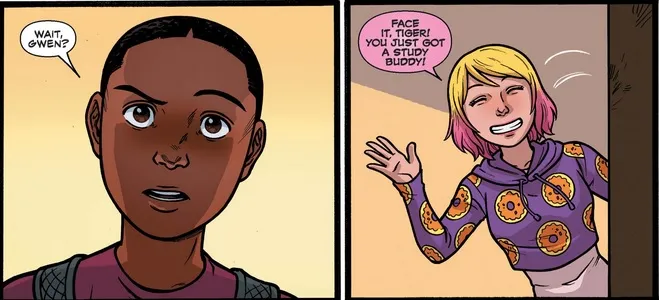
Once a regular person from our regular world, Gwen Poole, one day found herself trapped in the Marvel universe. She decided to use her knowledge of comics — and a lot of big guns — to profit as a mercenary named Gwenpool.
The one thing she didn’t do? Track down all her favorite characters for a kiss or a date. Gwen has no interest in anything that isn’t making money, buying explosives, or becoming “bros” with Miles Morales (who tragically does not appreciate her murderous tendencies). The closest she comes to expressing attraction is when she meets Doctor Strange, whom she describes as, and I quote, “hunka hunka wizard.” Which was my reaction too, so that’s fair.
Yelena Belova

Yelena was one of the Red Room’s best students. As such, she was allowed to (attempt to) take over the title of Black Widow after it was decided that the original, Natasha Romanova, was no longer “Russian” enough for the job. Needless to say, this didn’t go well for Yelena, but she hasn’t stopped trying to assert her superiority.
Her sexuality has not been mentioned in the comics, but Yelena’s creator, Devin Grayson, mentioned in a 2020 interview that Yelena would be “probably more likely to identify as asexual than to follow Nat’s romantic path.” Indeed, Yelena seems exclusively focused on her career and has no time for distractions of any kind, as Natasha herself noted not long after meeting Yelena.
Nadia van Dyne
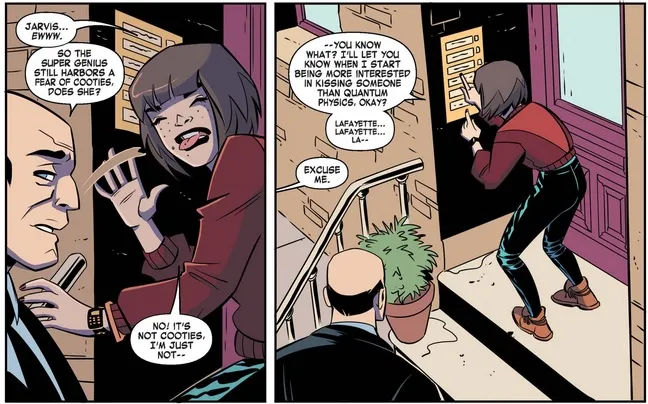
I don’t know what it is about the Red Room cranking out badass asexual women, but here’s another one. Nadia spent her entire life in the Red Room before she finally managed to escape and make her way to America, where she hoped to meet her famous father, Hank Pym, AKA Ant-Man.
Unfortunately, Hank was a little dead, so Nadia turned her attention to forming G.I.R.L., a band of teen science geniuses, and otherwise being the best Unstoppable Wasp she can. While she adores just about everyone and is very physically affectionate, she has repeatedly dismissed the idea of dating or going to bed with anyone. Nadia’s creator, Jeremy Whitley, has confirmed on Twitter that Wasp is aro-ace, though she has yet to use that language herself.
Connor Hawke
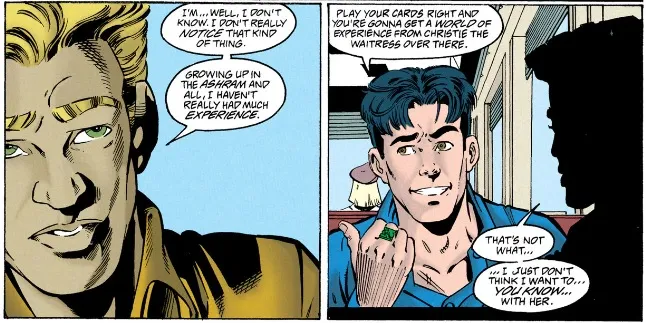
Here he is: the newest hero to come out as asexual! Connor Hawke/Green Arrow officially announced his asexuality in DC Pride 2022, but it was obvious to all and sundry for years. Having spent his formative years in a monastery, Connor didn’t have much opportunity for socializing or relating to people in a romantic or sexual context. Even after years of hanging out with the world’s sexiest superpeople, Connor never showed any inclination to make time with them.
As the son of (the decidedly sexual) Oliver Queen/Green Arrow, Connor has often felt that he has to live up to his father’s legendary image. As far as everyone else is concerned, he has done more than that. His coming out in DC Pride 2022 might even be a sign that he is finally confident in who he is and ready to share his true self with the world.
Can’t get enough queer superpeople? Check out this list!














